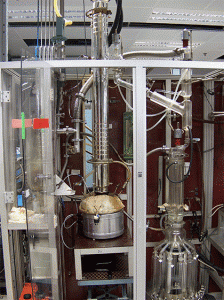The variety of compounds in crude oil range from light paraffins to heavy, aromatic compounds, each with its own set of operable temperatures and pressures ranges. In the first stage of distillation, the atmospheric distillation column is used to separate the heavy and residual oil from the light compounds that limit the further separation of the crude oil. Vacuum distillation involves a depressurized system, which increases volatility of the heavy oil and is ideal for separating the residual heavy compounds for further processing.
It is important to understand the limitations of input crude oil to avoid unwarranted cracking within the atmospheric distillation column, and the Watson Characterization Factor provides a rough estimation on that range. The relationship between KW and the decomposition zone at which temperatures alter the chemical bonds of the lighter compounds are well documented throughout academia and industry. To avoid coking within the distillation column with tremendous certainty, one must stay outside of the decomposition zone. However, as the video in the previous blog showed, decreasing the temperature gradient (from top to bottom of the distillation column) decreases the yield of other distillates or at least the rate of production.
Contrary to the trends we have studied, this Reuters article illustrates an ongoing issue with U.S. refineries processing lighter crudes. The demand for lighter, straight-run fuels is much more desirable in the non-American market. While heavier crudes continue to be discovered and exploited, the domestic supply of light crudes and condensates will certainly require more simulations and infrastructure to handle such wide varying capacities.

